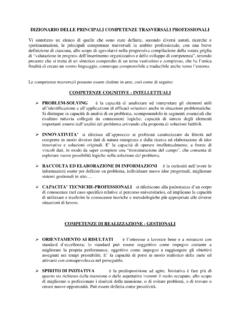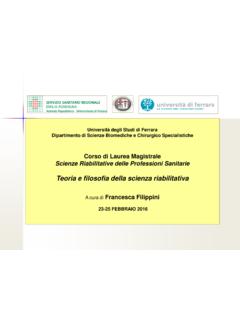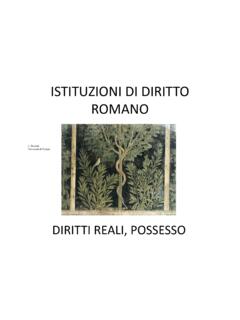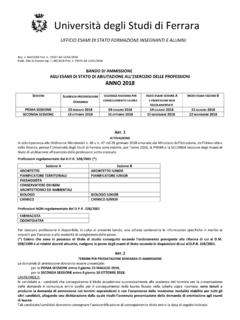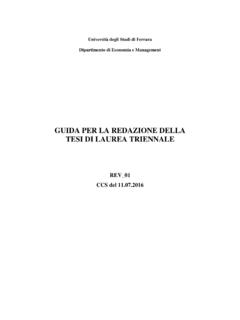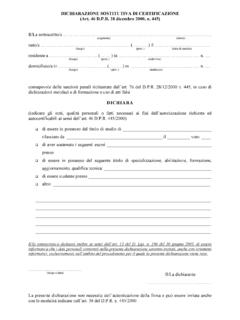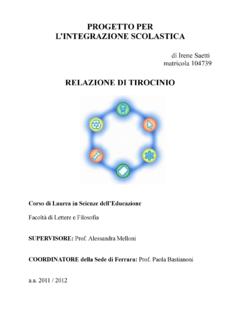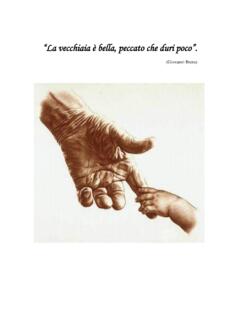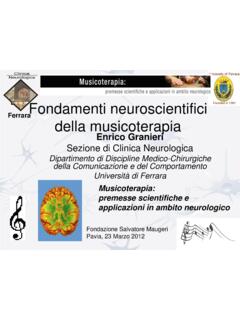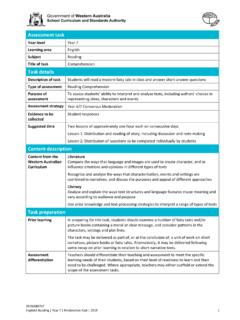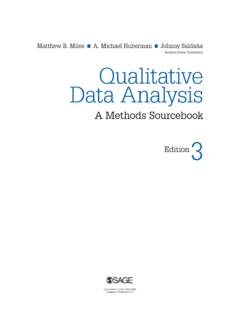Transcription of Fundamentals of Vibration - Unife
1 Galileo Galilei (15641642), an Italian astronomer, philosopher, and professorof mathematics at the Universities of Pisa and Padua, in 1609 became the firstman to point a telescope to the sky. He wrote the first treatise on modern dynam-ics in 1590. His works on the oscillations of a simple pendulum and the vibrationof strings are of fundamental significance in the theory of vibrations.(Courtesy of Dirk J. Struik, A Concise History of Mathematics(2nd rev. ed.), DoverPublications, Inc., New York, 1948.) chapter 1 Fundamentals of Vibration1 chapter OutlineThis chapter introduces the subject of vibrations in a relatively simple manner. It beginswith a brief history of the subject and continues with an examination of the importanceof Vibration . The basic concepts of degrees of freedom and of discrete and continuoussystems are introduced, along with a description of the elementary parts of vibratingChapter Outline1 Learning History of the Study of of the Study of Concepts of of Analysis or Inertia Using Literature80 chapter Summary81 References81 Review Questions83 Problems87 Design 8/21/10 2:06 PM Page 12 chapter 1 Fundamentals OF Vibration systems.
2 The various classifications of vibrationnamely, free and forced Vibration ,undamped and damped Vibration , linear and nonlinear Vibration , and deterministic andrandom vibrationare indicated. The various steps involved in Vibration analysis of anengineering system are outlined, and essential definitions and concepts of Vibration concept of harmonic motion and its representation using vectors and complexnumbers is described. The basic definitions and terminology related to harmonic motion,such as cycle, amplitude, period, frequency, phase angle, and natural frequency, are , the harmonic analysis, dealing with the representation of any periodic function interms of harmonic functions, using Fourier series, is outlined. The concepts of frequencyspectrum, time- and frequency-domain representations of periodic functions, half-rangeexpansions, and numerical computation of Fourier coefficients are discussed in ObjectivesAfter completing this chapter , the reader should be able to do the following.
3 *Describe briefly the history of Vibration *Indicate the importance of study of Vibration *Give various classifications of Vibration *State the steps involved in Vibration analysis*Compute the values of spring constants, masses, and damping constants*Define harmonic motion and different possible representations of harmonic motion*Add and subtract harmonic motions*Conduct Fourier series expansion of given periodic functions*Determine Fourier coefficients numerically using the RemarksThe subject of Vibration is introduced here in a relatively simple manner. The chapterbegins with a brief history of Vibration and continues with an examination of its impor-tance. The various steps involved in Vibration analysis of an engineering system are out-lined, and essential definitions and concepts of Vibration are introduced. We learn here thatall mechanical and structural systems can be modeled as mass-spring-damper systems.
4 Insome systems, such as an automobile, the mass, spring and damper can be identified asseparate components (mass in the form of the body, spring in the form of suspension anddamper in the form of shock absorbers). In some cases, the mass, spring and damper donot appear as separate components; they are inherent and integral to the system. For exam-ple, in an airplane wing, the mass of the wing is distributed throughout the wing. Also, dueto its elasticity, the wing undergoes noticeable deformation during flight so that it can bemodeled as a spring. In addition, the deflection of the wing introduces damping due to rel-ative motion between components such as joints, connections and support as well as inter-nal friction due to microstructural defects in the material. The chapter describes 8/21/10 2:06 PM Page HISTORY OF THE STUDY OF VIBRATION3modeling of spring, mass and damping elements, their characteristics and the combinationof several springs, masses or damping elements appearing in a system.
5 There follows a pre-sentation of the concept of harmonic analysis, which can be used for the analysis of gen-eral periodic motions. No attempt at exhaustive treatment of the topics is made in Chapter1; subsequent chapters will develop many of the ideas in more History of the Study of of the Study of VibrationPeople became interested in Vibration when they created the first musical instruments, proba-bly whistles or drums. Since then, both musicians and philosophers have sought out the rulesand laws of sound production, used them in improving musical instruments, and passed themon from generation to generation. As long ago as 4000 [ ], music had become highlydeveloped and was much appreciated by Chinese, Hindus, Japanese, and, perhaps, theEgyptians. These early peoples observed certain definite rules in connection with the art ofmusic, although their knowledge did not reach the level of a science.
6 Stringed musical instruments probably originated with the hunters bow, a weaponfavored by the armies of ancient Egypt. One of the most primitive stringed instruments, thenanga, resembled a harp with three or four strings, each yielding only one note. An exam-ple dating back to 1500 can be seen in the British Museum. The Museum also exhibitsan 11-stringed harp with a gold-decorated, bull-headed sounding box, found at Ur in aroyal tomb dating from about 2600 As early as 3000 , stringed instruments suchas harps were depicted on walls of Egyptian present system of music is based on ancient Greek civilization. The Greek philoso-pher and mathematician Pythagoras (582507 ) is considered to be the first person toinvestigate musical sounds on a scientific basis (Fig. ). Among other things, PythagorasFIGURE (Reprintedwith permission from L.)
7 E. Navia,Pythagoras: An Annotated Bibliography,Garland Publishing, Inc., New York, 1990). 8/23/10 4:58 PM Page 34 chapter 1 Fundamentals OF VIBRATION123 StringWeightFIGURE experiments on a vibrating string by using a simple apparatus called a mono-chord. In the monochord shown in Fig. wooden bridges labeled 1 and 3 are 2 is made movable while the tension in the string is held constant by the hangingweight. Pythagoras observed that if two like strings of different lengths are subject to thesame tension, the shorter one emits a higher note; in addition, if the shorter string is halfthe length of the longer one, the shorter one will emit a note an octave above the left no written account of his work (Fig. ), but it has been described by oth-ers. Although the concept of pitch was developed by the time of Pythagoras, the relationbetween the pitch and the frequency was not understood until the time of Galileo in thesixteenth ,Aristotle wrote treatises on music and sound, making observationssuch as the voice is sweeter than the sound of instruments, and the sound of the flute issweeter than that of the lyre.
8 In ,Aristoxenus, a pupil of Aristotle and a musician,FIGURE as a musician. (Reprinted with permission from D. E. Smith, Historyof Mathematics, Vol. I, Dover Publications, Inc., New York, 1958.) 8/21/10 2:06 PM Page HISTORY OF THE STUDY OF VIBRATION5wrote a three-volume work entitled Elements of Harmony. These books are perhaps the old-est ones available on the subject of music written by the investigators themselves. In about300 , in a treatise called Introduction to Harmonics, Euclid, wrote briefly about musicwithout any reference to the physical nature of sound. No further advances in scientificknowledge of sound were made by the Greeks. It appears that the Romans derived their knowledge of music completely from theGreeks, except that Vitruvius, a famous Roman architect, wrote in about 20 theacoustic properties of theaters.
9 His treatise, entitled De Architectura Libri Decem, was lostfor many years, to be rediscovered only in the fifteenth century. There appears to have beenno development in the theories of sound and Vibration for nearly 16 centuries after thework of experienced many earthquakes in ancient times. Zhang Heng, who served as ahistorian and astronomer in the second century, perceived a need to develop an instrumentto measure earthquakes precisely. In he invented the worlds first seismograph [ , ]. It was made of fine cast bronze, had a diameter of eight chi (a chi is equal to ), and was shaped like a wine jar (Fig. ). Inside the jar was a mechanism consist-ing of pendulums surrounded by a group of eight levers pointing in eight directions. Eightdragon figures, with a bronze ball in the mouth of each, were arranged on the outside of theseismograph.
10 Below each dragon was a toad with mouth open upward. A strong earth-quake in any direction would tilt the pendulum in that direction, triggering the lever in thedragon head. This opened the mouth of the dragon, thereby releasing its bronze ball,which fell in the mouth of the toad with a clanging sound. Thus the seismograph enabledthe monitoring personnel to know both the time and direction of occurrence of the worlds first seismograph,invented in China in (Reprinted with permission from R. Taton (ed.), History of Science,Basic Books, Inc., New York, 1957.) 8/21/10 2:06 PM Page 56 chapter 1 Fundamentals OF VIBRATIONG alileo Galilei (15641642) is considered to be the founder of modern experimental sci-ence. In fact, the seventeenth century is often considered the century of genius since thefoundations of modern philosophy and science were laid during that period.

